
Miramichi Salmon Blog – High Summer 2024
Fishing Friends –
Thanks to catching a nasty virus that was working through the camp in Newfoundland I’m home in Maine. First, a review of what I know about the salmon season in general so far… I think it is fair to say waters in the middle and southern parts of North America’s salmon range have been finding this a tough season. A friend who fished on the Flowers River, Labrador’s furthest north scheduled salmon river, and another who fishes the Sandhill River in mid-south coast of Labrador reported excellent or even better than that fishing. Reports that I have from the Gaspe and New Brunswick are not that great. One reader wrote me that friends of his fishing the Restigouche were not only failing to catch anything but weren’t even seeing any either. It is a fairly well-known fact within the conservation community that excessive netting, including a period at the end of May and beginning of June that targets those huge three MSW fish has greatly reduced the river’s spawning stock.
Two anglers I know fished the FN owned and run Micmac Camp on the vaunted Cascapedia River around the first of July. They spent a week there in prime time at eye-watering expense and did not even have a pull. The pools they said were essentially devoid of salmon. At mid-week the guides sheepishly admitted that protesting First Nations people had netted the mouth of the river and removed over 1,000 salmon. We also heard that there were 25 striped bass for every salmon I have no way of completely verifying either of these numbers, but I have heard them from several reliable sources.
The run in the Cascapedia varies from a low of under 1,000 adult spawners, to a modern high of still only 4,500 from just a couple of years ago. Netting out 1,000 has to produce major damage to the spawning stock – talk about shooting yourself in the foot.
Over in Newfoundland I heard from a number of anglers who had recently fished the Harry’s, Gander, Exploits, Humber, Big East, Torrent, River of Ponds and some smaller ones. The word is that the runs this year to date have been relatively poor. I just returned early from the Serpentine River. We did catch fish – both salmon and grilse – but the number present in the pools was a lot less than normal for this time of the season. The water by my thermometer was around 21C/70F for the whole time I was there. This is not hot by Miramichi standards, but it is for Nwfld, and really marginal for Atlantic salmon. It cooled off the last couple of days I was there, and I hear from the outfitter that fresh fish are now showing up and are in more of a taking mood.
Closer to home, the Miramichi did get down to 20.2C/68F on Wednesday morning for the first time since July 1. This is good for the salmon that are in the system and waiting it out in the brook-fed pools, but it is nowhere near cool enough to re-open those pools for fishing. We need three consecutive days that reach below that temperature, and there needs to a reasonable forecast ahead of us. The forecast right now is for high 20C temps to resume in a couple of days, and there is now about a week of those abominable temperatures forecast to begin this weekend.
The Millerton and Cassilis DFO trapnet numbers are in through July 15 and they are a surprise on the upside when it comes to MSW salmon. The SW counted 122 and while it is down by about 50% from the 2006 to 2015 average, it is roughly equal to the 2001 through 2005 average of 129. On the NW the count of 47 is about 20% behind the 2001 through 2006 count of 60. Both branches are about triple last year’s count for the same date, but I’m confident that can be explained by the very high water of that time last summer. High water can cause the run to avoid the trap net. You can check the trap numbers out yourself at this link.
Grilse numbers for the same date are utterly disastrous. They can be summed up in the Dungarvon Protection Barrier count where only 4 grilse have been taken so far. Since 2015 the average for this date had been holding in the 40s. We thought that was bad enough since it had been about 200 a year in the early 2000s. One has to wonder how much this poor performance has to do with the consistent, well-known, ruthless poaching done in the Dungarvon by First Nations members from the Tobique area?
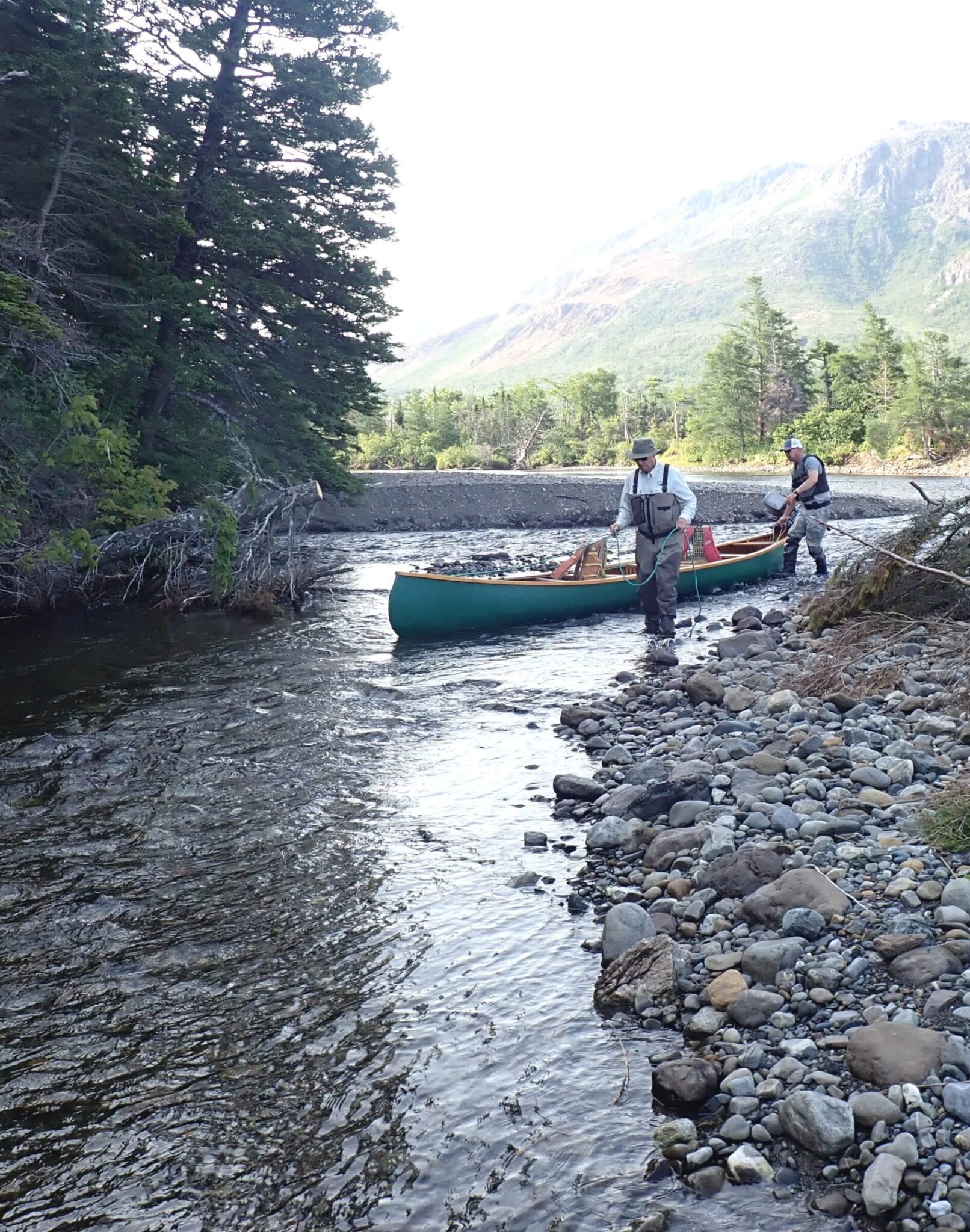
Newfound Outfitter’s owner and guide Paul Rogers gets some help from Dawson Hovey lowering a canoe down through a tough spot on the Serpentine.
There is also some big news on the Miramichi conservation front. The DFO Minister Diane Lebouthillier made a surprise visit to Eel Ground First Nations and in front of a group of FN members as well as conservation groups like the MSA, NBSC and ASF announced an increase in the commercial quota from the current 50K fish to 175K fish! I don’t believe that anyone saw that coming, though some may claim to have. It was speculated to me by a respected source that the Minister’s staff in Ottawa had read Doctor John Ritter’s Report – if you haven’t read this report, you are missing perhaps the best piece of information available on the subject – and it motivated the minister to cut through all the b.s. and make this move to increase the commercial bass quota.
Since the announcement the internet has been abuzz with comments of all sorts, and I’m now going to add mine to them.
- The increase in the commercial quota to 175K is good news, and we all need to thank the conservation group volunteers – as well as all those individuals who sent in their letters starting back in the winter – especially including the MSA, NBSC, and the ASF – though there are definitely others too – who have worked very hard on this issue. It shouldn’t be that hard to move DFO to protect Miramichi salmon, but it is.
- We need the bass population down to 100k from the current god knows what, but probably well over 500K. It is very likely that combined with the recreational harvest it would get us there eventually, and in fact the quota would have to be reduced along the way. You can’t harvest 175K individuals out of a stock of 100K! On the other hand, the old formula I remember from the striped bass wars in America was that the F=msy (fishing mortality at maximum sustainable yield) for striped bass was something like 49%. In fact, DFO emeritus Gerald Chaput referred to a sustainable 50% mortality on striped bass. That means that the maximum sustainable yield for striped bass is reached when fishing mortality reaches 49%. If you go above that the population drops, below that level it grows. 175K/.49 = 357K. That would mean we could continually harvest 175K striped bass and maintain a population of 357K – more than triple the 100K max striped bass that we need. That would indicate that we start higher, maybe much higher than 175K to begin to decrease the population. At 100K we could continually harvest 49K. If the recreational fishery is catching 25K then that would leave just 24K for a commercial quota.
- This all brings me to my second point. We received no explanation from DFO of where the 175K number came from. I know that DFO has people who know all these things very well. I don’t pretend that my numbers presented above are really accurate for the scenario that exists in New Brunswick, but the basic concept is right. What was DFO’s formula, values and expected ending point for calculating the 175K commercial quota? That information shouldn’t be shrouded in secrecy.
- How will this 175K be caught? For the first time since the commercial fishery was started several years ago at Eel Ground on the NW Miramichi the 50,000 quota looks like it will be reached. According to Nathan Wilbur that is because FN has finally been given more trap nets. Why wasn’t this done after the first year that the quota was missed? We are now talking about a 350% increase in that quota. I understand that DFO is giving it all to First Nations interests.
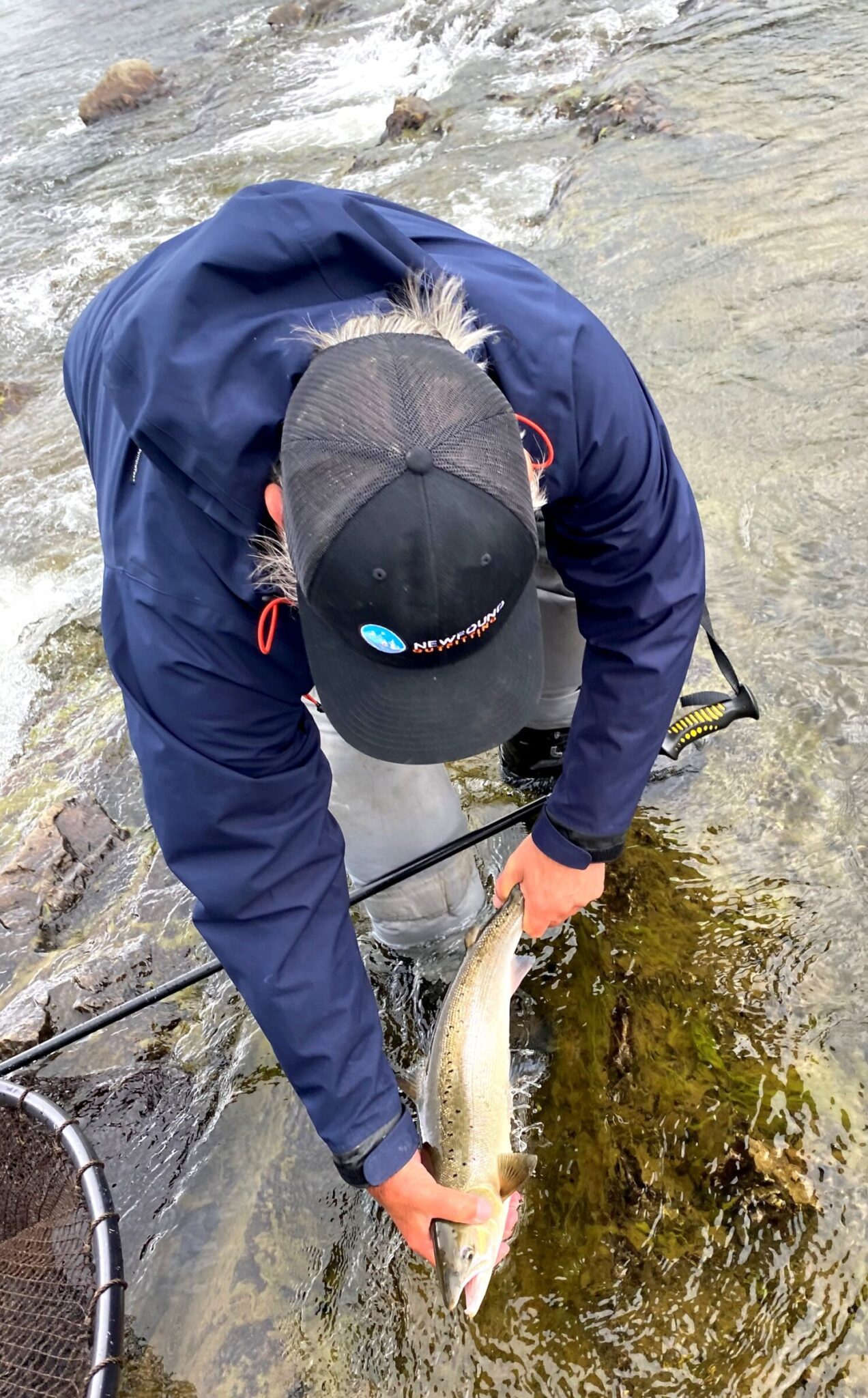
English Dr. Tim Morgan releases a Serpentine grilse. It was Tim’s third week in Newfoundland during 2024.
That isn’t at all fair or sensible. The European settlers netted 250,000 pounds of striped bass through the ice in the NW Miramichi annually in the mid-1800s. Why aren’t the non-indigenous commercial fishing interests in Miramichi Bay being allowed to participate in this fishery? These people already have fixed trap nets for gasperaux. They already catch tons of striped bass and are forced to just open their traps and let them all go. I’m told DFO officials are often standing right there to make sure no stripers are harmed… They could probably catch any amount of stripers without any new investments in gear and training. If DFO buys new nets for FN and then the quota has to be cut back in 5 years what a howl there will be. Why not just make it an open quota for all users, keep track of the landings, and if it looks like it will be exceeded just close the season and readjust for the next year. Let interested FN fishers participate along with non-indigenous. This to me seems fair, makes sense, and would be the most efficient in several ways. Down the road when it is determined what the sustainable striper harvest really is, if the government wants FN to have the entire fishery they can buy out the non-indigenous participants and give the quota to FN. Making this a FN only fishery will just dial in delay in catching the needed number of fish. We can’t afford to lose those years.
- To anyone’s knowledge, DFO has not at all embraced the 100K number as the maximum number of adult striped bass that can spawn regularly in the Miramichi – if we are to have a good salmon population too. In fact in a recent letter received by a salmon biologist I know DFO is continuing to stand behind a 330K lower reference point number. The correctness of this number is challenged by just about everyone except DFO who refuses to have their calculations independently peer reviewed. But 100K is where we have to be for salmon to recover in the Miramichi. This to me is the biggest difference between USA and Canadian fisheries management. In the US, National Marine Fishery Service, or in East Coast inshore waters the Atlantic States Marine Fisheries Commission, openly state all of the statistics, formulas etc that they are using. They would articulate what their goals were. You might disagree with them, and you could challenge them, but you would know the government’s real position on the issue. In some cases they are challenged in court, sometimes prevailing, sometimes losing, but in all cases the government made it clear what they were doing. The process was reasonably transparent. I understand that by their mandate DFO is required to balance these resources. It is not acceptable to manage one species for abundance knowing it will extinguish another one – especially the most iconic species in maritime Canada, the Atlantic salmon.
- The Minister did say that one of the goals with the expanded quota was to help fish populations that were stressed by striped bass over-abundance. It is helpful to at least hear that admission, but what are they planning to do about it? The Miramichi is by no comparison the most important Atlantic salmon fishery in Canada. It has many more participants, more lodges, more invested riparian owners and generates more license sales than all other rivers. The population has been very visibly in decline since 2011. A strategy by DFO to correct this situation was overdue 10 years ago, but there is still none today. We need DFO to support a robust hatchery program to go along with reducing the bass numbers.
In any case, there are good people working away on all these issues, and at least this situation is out in the light of day and people are working on it.
Let’s hope for some good progress and a decent fall run this year on the Miramichi.
Thanks for reading. Brad Burns


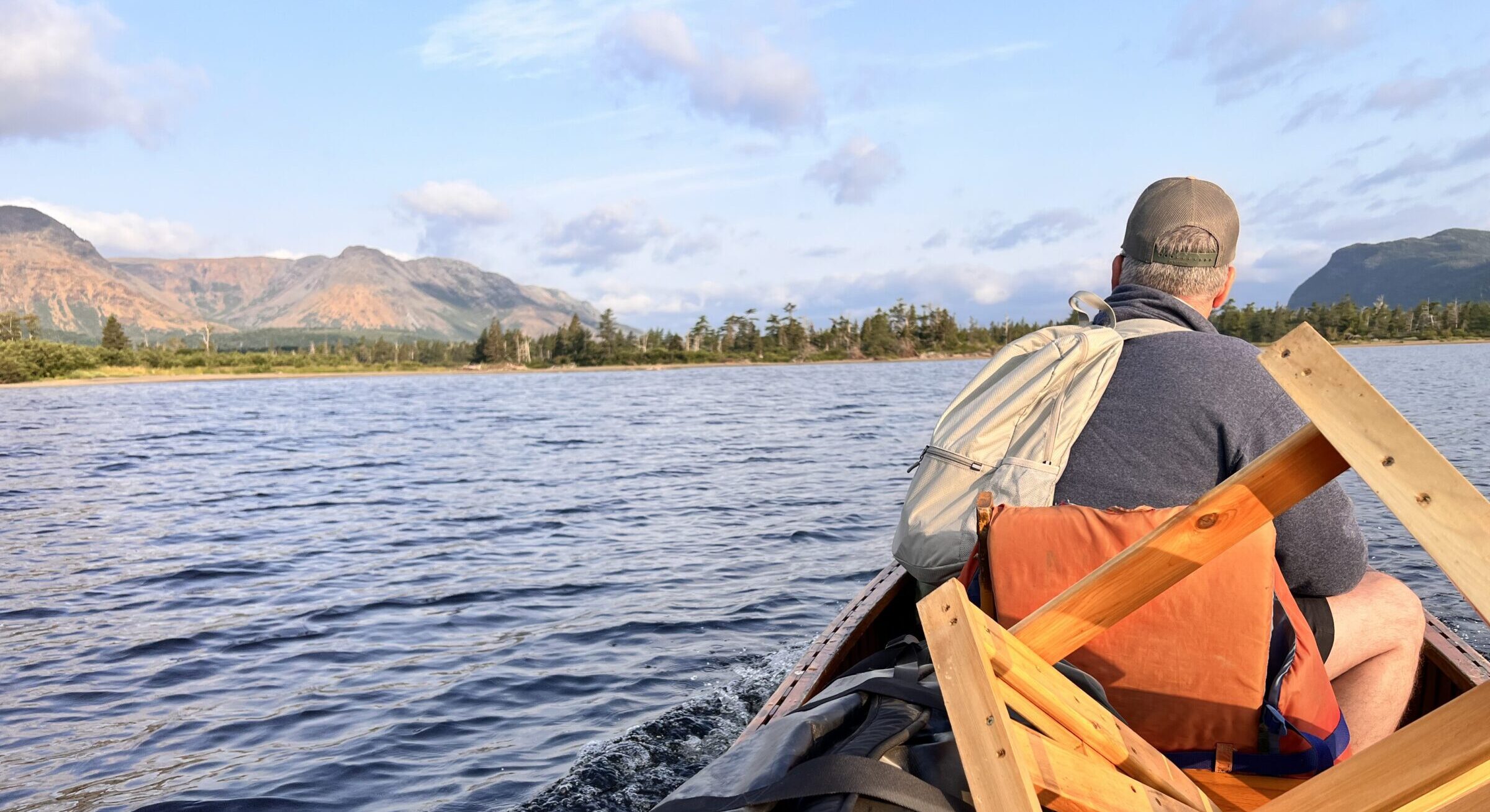
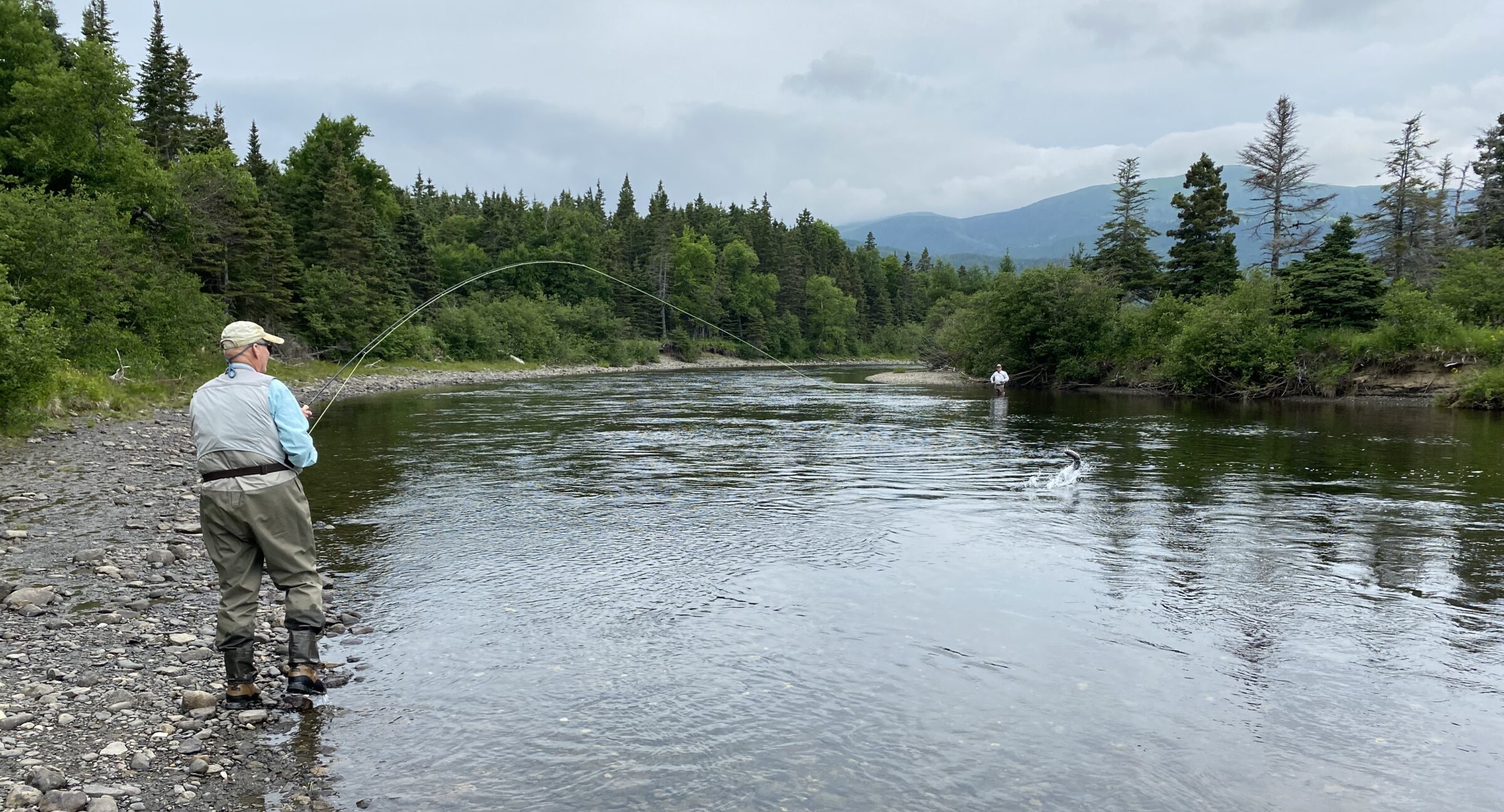
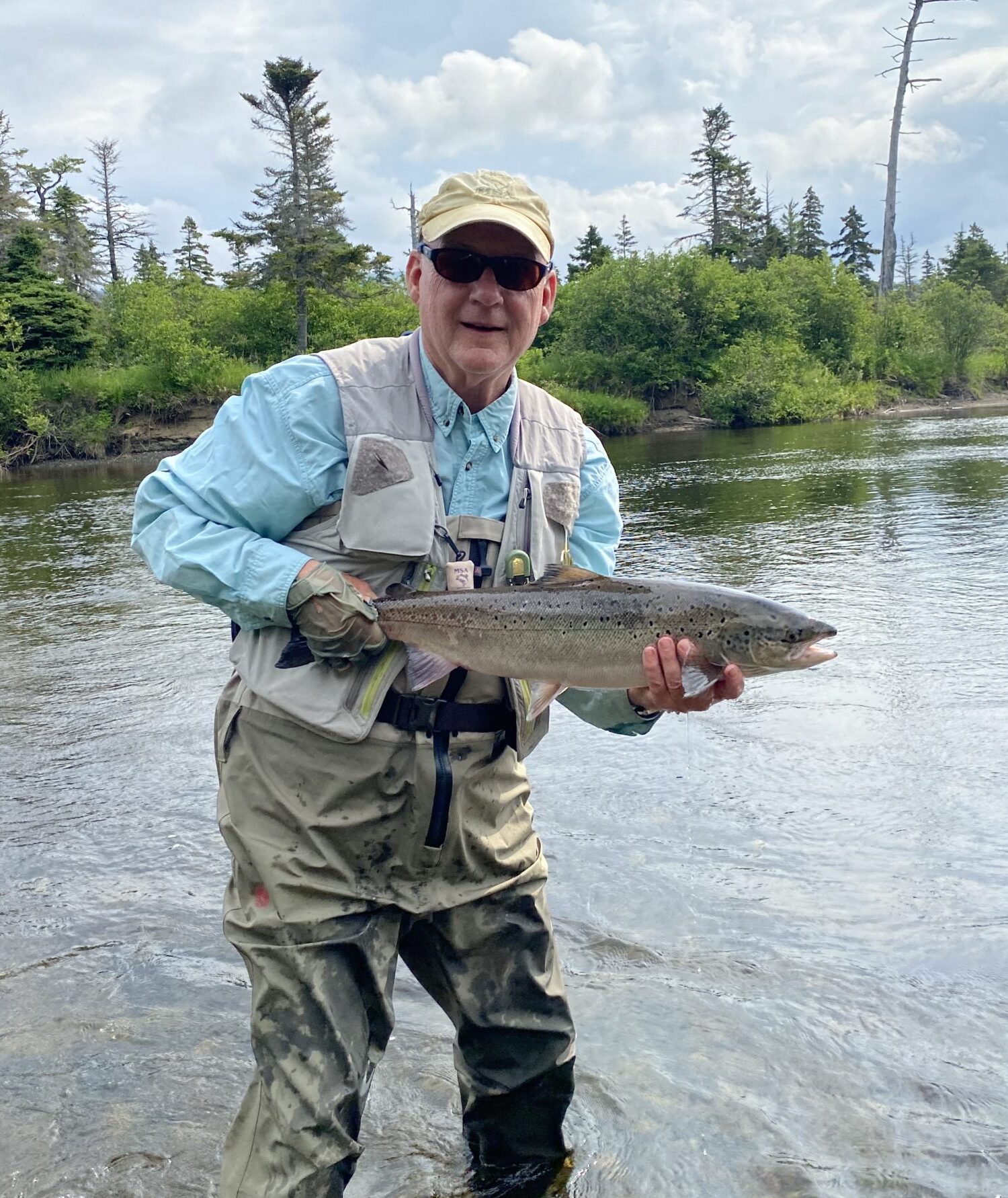
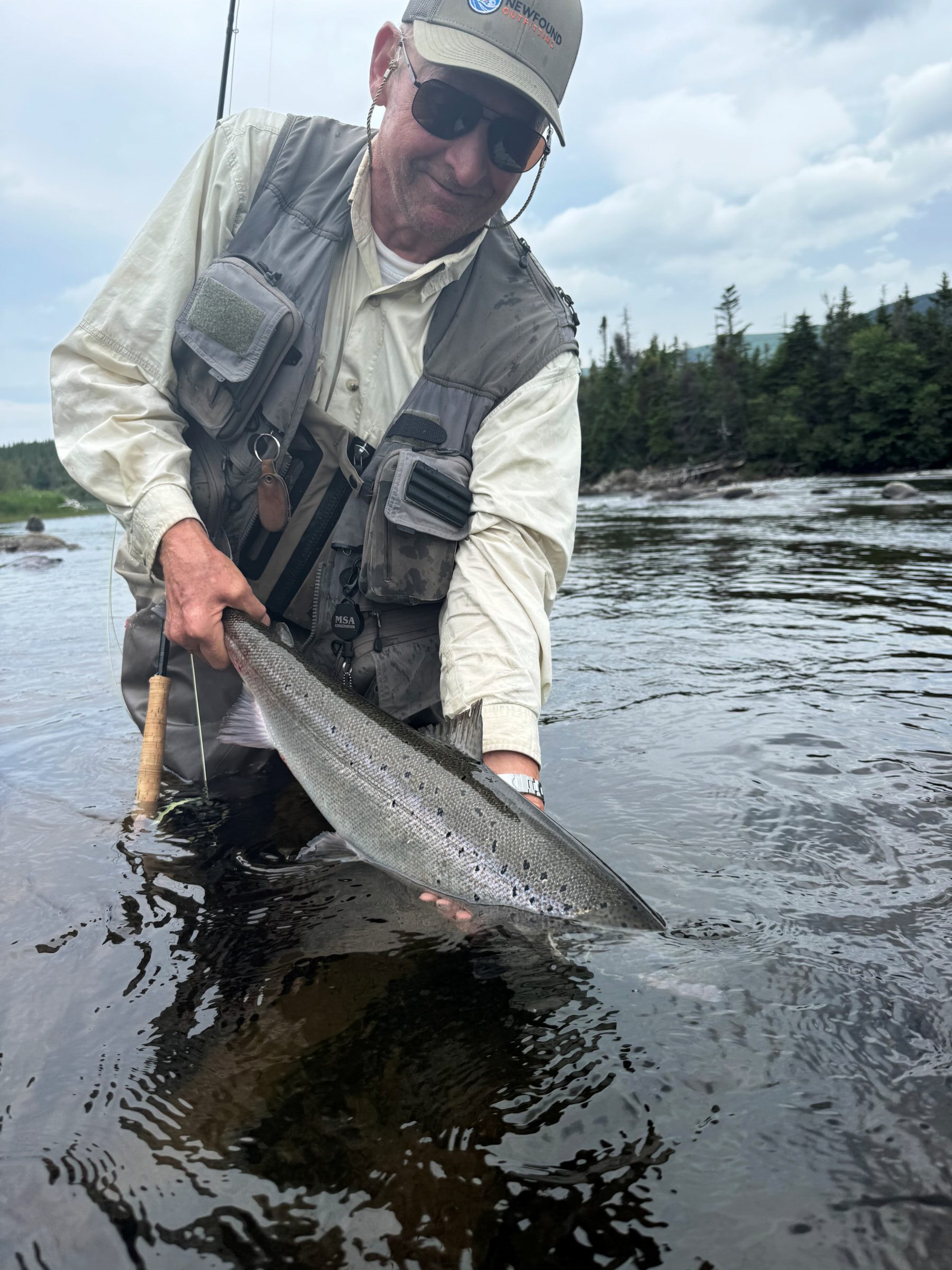
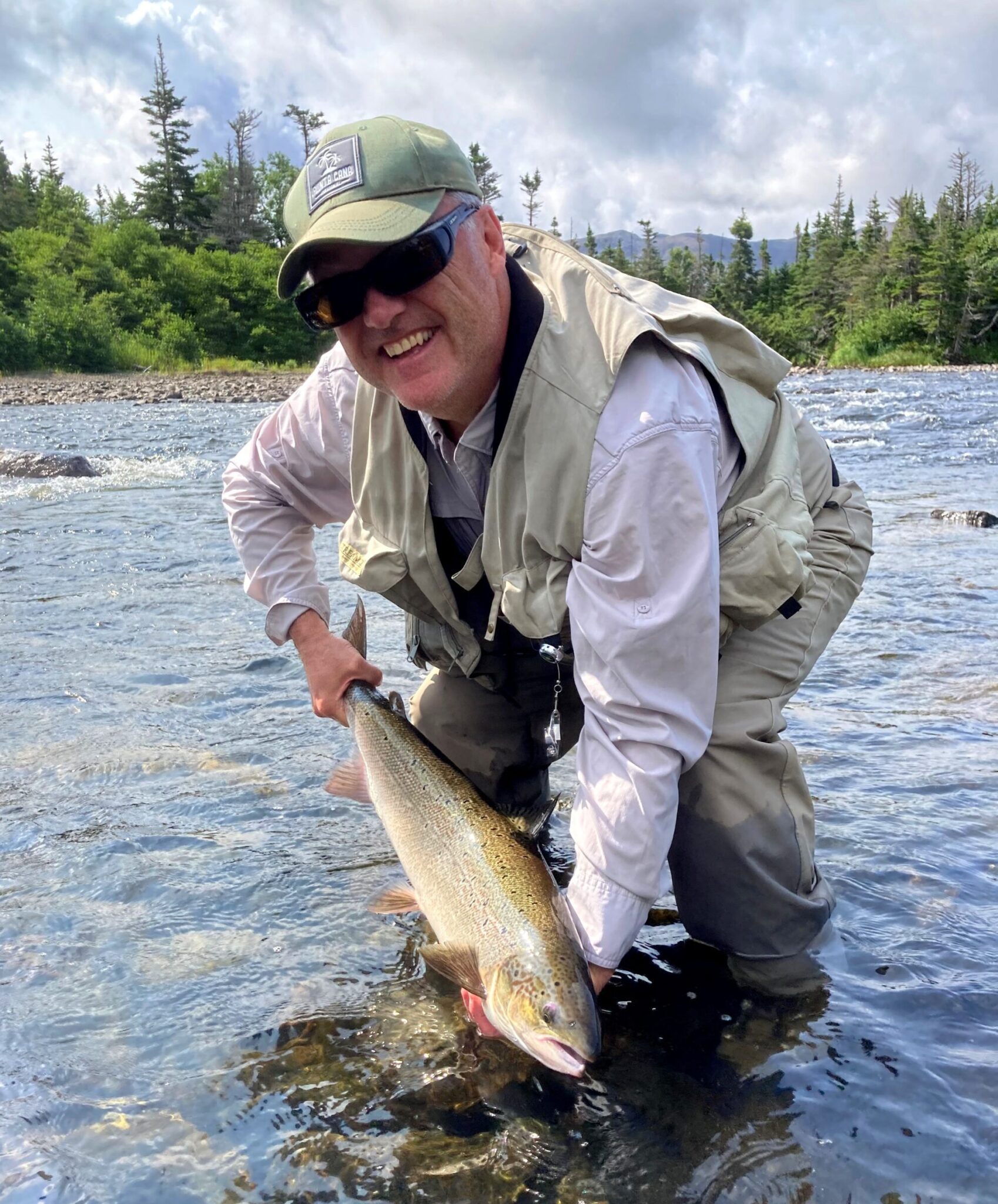
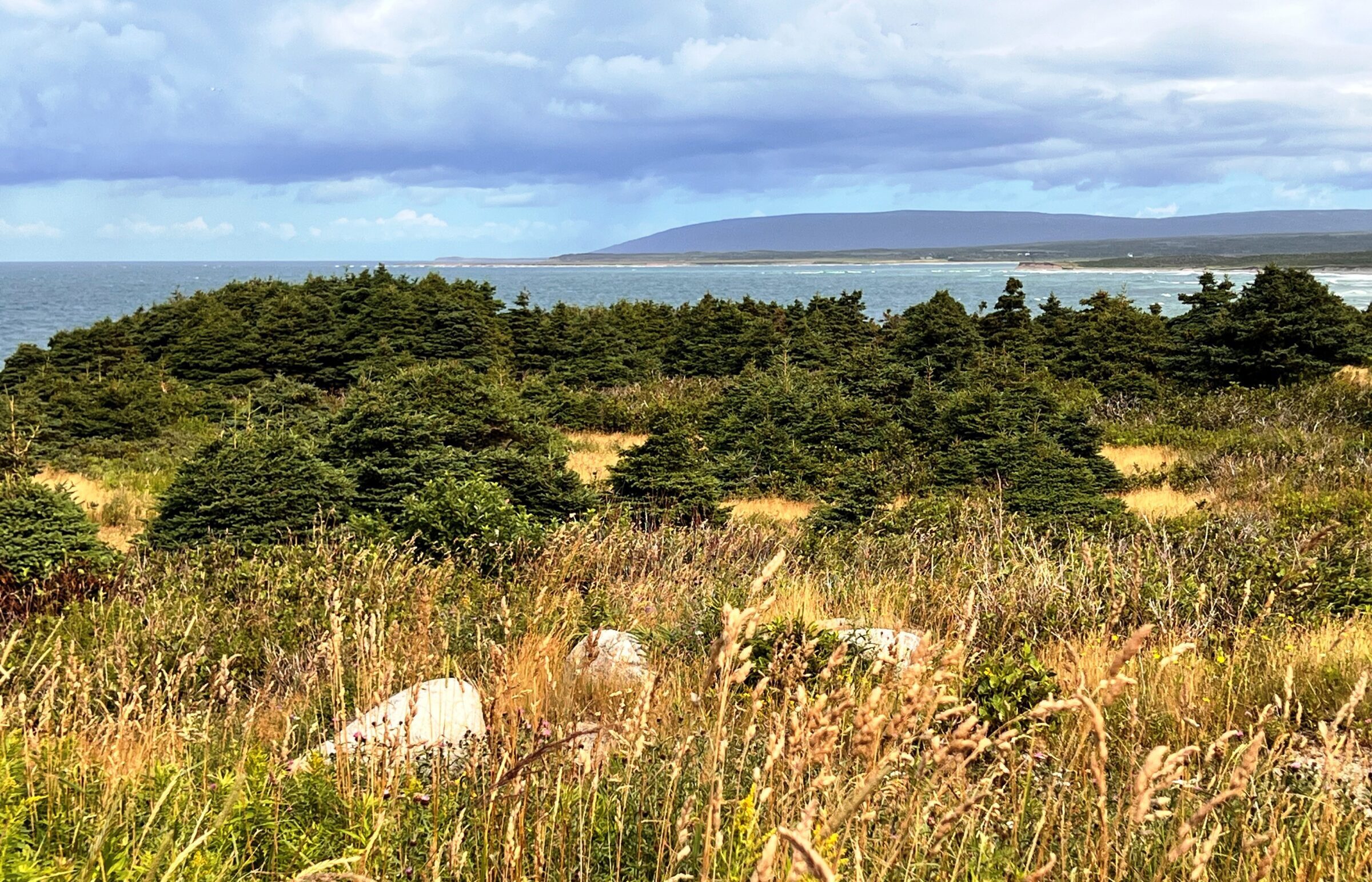
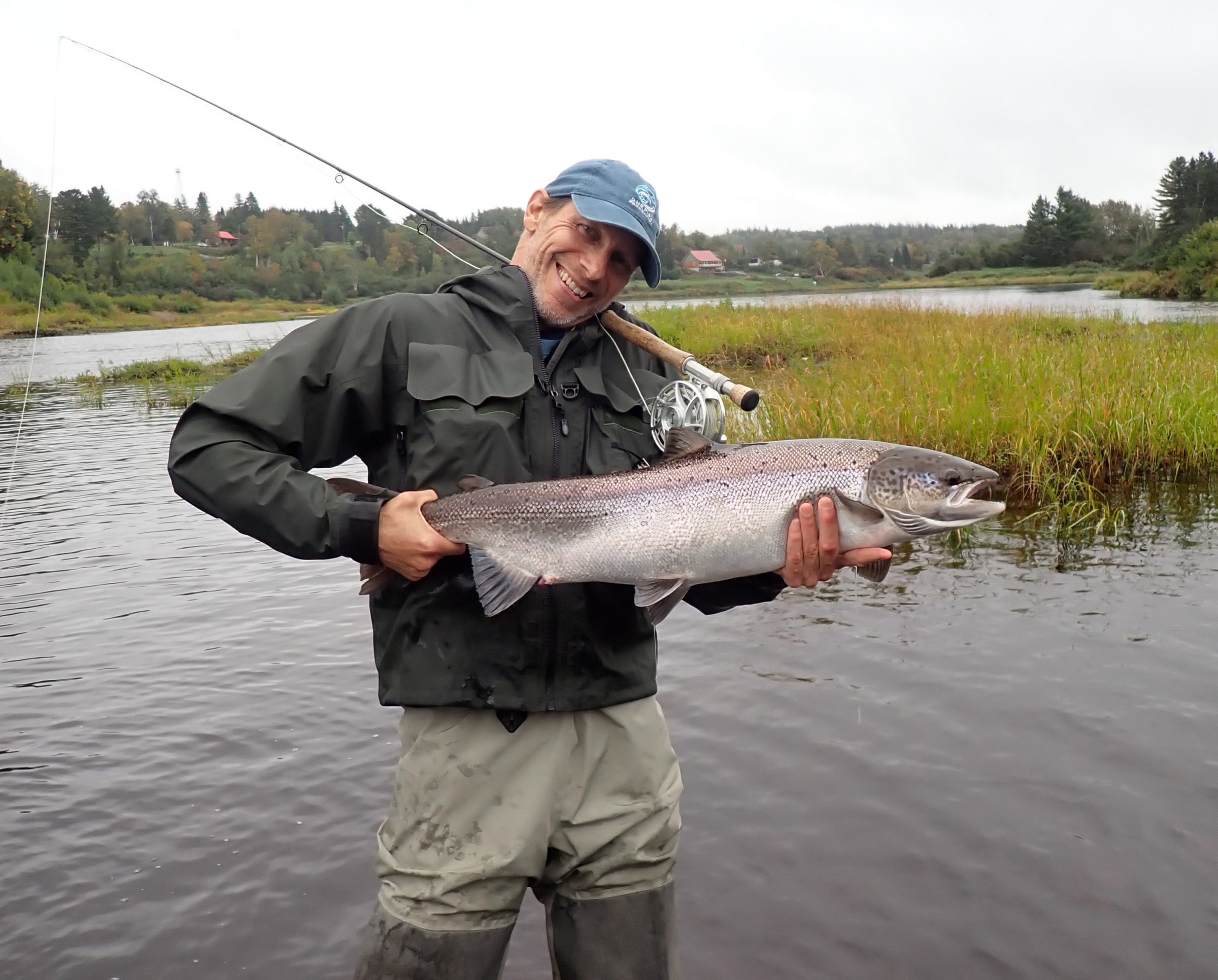
Thanks Brad
Tom MacLean, s, ceo, bc
Miramichi. NB
flyfishingconsulting@mail.com
Stripers being addressed 10 years late while the smallmouth bass are just getting started. I don’t know how a river can rebound looking at the grilse numbers and seeing them halve every year. My optimism is halving every year along with them.
The same department in Canada (DFO) responsible for managing, in Canadian waters, the cod fishery into near collapse in NL are now opening it again against advice to the contrary. They’ve received good advice on how to manage the stripped bass fishery on the Miramichi but again fail to listen and are reluctant to share their reasoning. We also know the capelin, herring, mackeral and other species, some of which Atlantic salmon, seabirds and other species feed on are also in significant decline in Canadian waters and other jurisdictions as well. We need to keep hounding our politicians to have more oversight of the departments responsible for our Atlantic salmon and other species before we have nothing left but striped bass.
Thank you, Brad, for your thoughtful and comprehensive report. You were fortunate to hook into some salmon during your time in Nfld – happy for you! Like you, I’m holding out hope for a back-ended bell curve that sets us up for spectacular fall fishing, though I’m not holding my breath!
To pick-up on your reports from Restigouche and Gaspe rivers this season. Two friends of mine just fished the Upsalquitch July 22-24 and only hooked two salmon. They are experienced fishermen with much knowledge of this stretch, and they saw very few salmon in the pools, even the two cold refuge pools. Another friend recently returned from a week on Restigouche and saw one lousy salmon, not even a pull, roll or boil the entire trip! The weather has certainly been a factor, but the trend across the region doesn’t bode well for our beloved salmon.
More shockingly, I’m sad to share that this week I saw posts that were made on the “NB crown reserve reports” Facebook group page citing that rainbow trout are now being hooked and landed on the Upsalquitch, as far up stream as the SE branch. In fact, a gentleman fishing the Forks pool landed a rainbow this past week. If not for the photo, and others sharing their pics, I would have never believed it. Apparently, unbeknownst to me, rainbow trout are being reported as in issue now facing many Bay de Chaleur salmon rivers!
This is very concerning to me. Between the growing numbers of seals, striped bass, smallmouth bass, and now Rainbow Trout (!!), our salmon don’t stand a chance. I have long believed there is strength in numbers and we now know all the salmon school together to travel to Greenland. So this new apparent issue facing our northern rivers in NB and Que impact all our rivers.
What can we do? I do know we can’t wait for DFO or politicians to act!